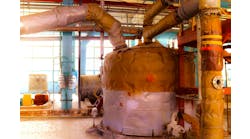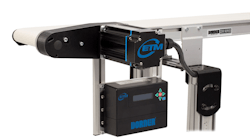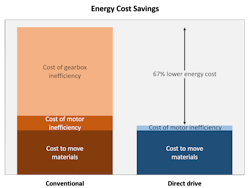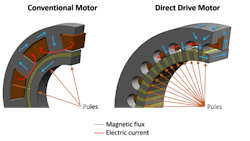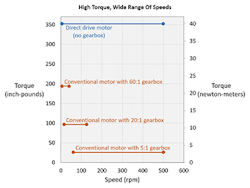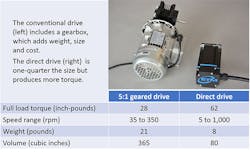A new compact direct drive technology, originally developed for electric bikes and fans, enables conveyor drives and other material handling systems to double their speed range and achieve 60% higher energy efficiency over conventional conveyor drives.
The manufacturer, Electric Torque Machines, which has developed the innovative system with Dorner Manufacturing Corp., says they are 20% less expensive, as well.
Dorner is launching their direct drive conveyor system this February.
“Electric Torque Machines’ technology has simplified our conveyor drive package offering, cut out SKU count almost in half, and cut our costs considerably,” says James Lubow, Dorner’s product manager. “The simplified design and SKU reduction is beneficial for our customers as they are stocking fewer service parts and can use this universally across our largest conveyor line. With many customers running their plants 24/7 we expect them to benefit greatly from this reliable system.”
The technology eliminates the need for a gearbox, because it uses motors that generate high torque even at low rotational speeds – so no gearbox is needed. This has an immediate impact on efficiency.
Direct drive motors have up to 10 times more electromagnetic poles.
A large conventional drive may have a motor with 75% efficiency and a gearbox with 40% efficiency – total energy efficiency only 30%. Electric Torque Machines motors can operate at over 92% efficiency, slashing energy consumption by about two-thirds. “We’ve heard from our customer community that they have measured gearmotor efficiency below 20%,” says Thomas Janecek, Electric Torque Machines CTO. “That’s 80% of the energy being dumped as heat!”
The drives are small, but the impact can be huge. In a plant with 250 conveyors, typical savings are more than $300,000 per year. The average material handler wage is $13.39, less than $28,000/year, meaning switching to direct drive may pay up to 10 of their salaries.
Removing the gearbox also reduces inventories; a single direct drive motor can be used for applications requiring many speeds and loads.
Electric Torque Machines direct drive motors provide smooth control adjustments from zero to full speed.
Conveyors move both large and small objects at relatively slow speeds, sometimes with frequent starts and stops. Conveyor drives, the motorized systems that move the conveyor belt, require high torque to meet the acceleration and load-carrying capacity requirements of each conveyor.
Conventional motors produce insufficient torque to enable direct drive, so a gearbox is usually needed to match high motor speeds to slow conveyor speeds – like a driver shifting into low gear when going uphill.
But gearboxes add cost and complexity to the drive system – several additional moving parts and lubricant seals, all of which are prone to failure. Worm gears used in conveyors are relatively inexpensive but notoriously inefficient, especially when used across a range of speeds and loads.
The possibly revolutionary development has been nearly a decade in the making.
“We started work in 2007, looking at a broad variety of applications, and determined that our competitive advantages – low cost, high efficiency, small size, low weight and high reliability – were a great fit for applications less than 1000 rpm. Then we realized that this same characteristic – eight or more times higher torque at low speed – was a perfect match for conveyors and other material handling equipment.”
According to Janecek, direct drive systems are being developed for a broad variety of material handling and industrial applications, such as robotics, pumps, and powered prosthetics.
“Our technology provides benefits at all speeds, but we’re primarily focused on applications under 1000 rpm, because that’s where it’s really a game-changer,” the CTO says. “For any application in that range, we’re confident we offer the lowest total cost, smallest size and weight, best efficiency, and highest reliability.”






